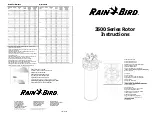
21
CARE AND MAINTENANCE
If you should happen to drip or spill fuel on the fi nish of your TS3,
carefully wipe it off as soon as you can. Some fuels, especially high
nitro fuels and special oil additives can damage your boats fi nish.
After you’re done boating for the day, you are going to want to add
some after-run oil to the engine to protect the internal parts. We
recommend removing the glow plug, opening the carburetor all the
way, and placing 10 to 12 drops of after-run oil down the barrel of
the carburetor. Place a rag over the glow plug hole and turn the
engine over with the electric starter. Repeat this step a least one
more time to make sure the inside of the engine is fully coated.
Replace the plug and wipe the boat down with cleaner.
It is also a good idea to open the radio box and unplug the battery
from the switch harness. Leave the lid off the radio box overnight to
make sure any water that might have entered can evaporate.
Clean the exterior of the boat and check over the mounting hardware.
HULL TUNING TIPS
PERFORMANCE PROPS WORTH NOTING:
AquaCraft GrimRacer
AquaCraft GrimRacer
40x52/3 Metal Prop
40x53 Metal Prop
AQUB9720
AQUB9715
MAJOR TUNING AREAS OF YOUR TS3:
➧
Propeller Shaft (Stub Shaft) Height
➧
Propeller Shaft (Stub Shaft) Angle
➧
Hinge Pin Angle
➧
Center of Gravity (CG)
➧
Propeller
➧
Rudder Defl ection
Propeller Shaft (Stub Shaft) Height:
To simplify, what we are trying
to do with propeller shaft height is to “raise the propeller to a height
that gives us the greatest speed with the least loss in stability”. Let’s
expand on this.
To measure the height of the shaft most racers use a setup board. A
typical tunnel hull setup board can be a simple piece of shelf board
with a slot cut into on end so the user can reference the height of the
prop to the bottom riding surface of the sponsons.
Adjusting the shaft height plays a huge part in the speed as well as
the handling of the boat. Typically, adjusting the propeller higher
STARTING AND OPERATION
Check and adjust the high-speed needle on your engine for a safe
break in setting (2 turns out for the OS XM Outboard Engine) The
prop that is supplied with the OS engine will operate the boat just fi ne
but most boaters use metal props as they provide better handling as
well as speed and power.
1. Using a hand or electric fuel pump (hand crank is recommended)
fi ll the fuel tank through the line that attaches to the carburetor.
2. Turn the transmitter on and then the receiver, in that order.
3. Attach the hand held electric starter to a 12V battery and choke
the engine by placing your thumb over the barrel of the carburetor.
Turn (Crank) the engine over with the starter 3 or 4 times in short 2
second bursts.
4. Install the glow igniter and crank the engine. It should start in less
than 10 seconds. If it takes longer than that, re-prime the engine
by removing the igniter and re-choking the engine. Repeat this if
needed until you have the engine running.
GrimRacer Says:
It is VERY important to NEVER run the engine
with the carburetor fully open with no load
on the propeller. The engine can, however,
sustain high idle for a minute or two and not
be damaged. Bottom line, you are going to want to launch the boat
into the water as soon as practical.
5. After the engine is running, launch the boat, applying a little more
throttle before the boat touches the water. Drive the boat straight
way from you at around half throttle to check the steering center. If
needed, adjust the steering trim on your transmitter for straight and
true tracking.
➧
Your Top Speed 3 can turn either left or right quite well but due
to prop torque the boat turns best to the right (Clockwise). You can
start breaking the engine in by making large, right-hand, oval shaped
circuits. Throttle up and down during the run to keep the engine
running and to load the engine throughout the throttle range. Before
the boat runs out of fuel (about 4 minutes), bring in the boat and allow
the engine to fully cool. Repeat the same break-in run one more time
before we start to lean down the engine for the fi nal break-in runs.
➧
When you’re ready to bring the boat in, drive it parallel to shore and
push back on the trigger to stop the engine. Never bring your boat
to shore by driving it straight at you. Always drive parallel to shore,
stop the engine and then retrieve the boat. This way if your engine
does not stop you can still go around and make another attempt.
➧
Finish breaking in the engine per the engine manufacturer’s
recommendations.
➧
If you should happen to fl ip your TS3, you are going to need
to remove any water that might have entered the engine. We
recommend removing the glow plug and turning the engine over a
few times by hand to remove water. After most of the water has been
removed, leave the glow plug out and turn the engine over with the
electric starter expelling the rest of the water.. Make sure you hold a
rag over the glow plug hole.
NOTE:
Be careful to keep your rag and
fi ngers away from the spinning prop. Re-install the glow plug and
start the engine. It is best to start the engine after you have fl ipped
the boat to make sure
ALL THE WATER IS OUT OF THE ENGINE.
It
is also a good idea to inspect the radio box to make sure no water
entered the radio compartment.




































